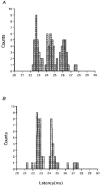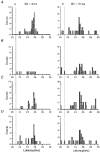Paired-pulse magnetic stimulation of the human motor cortex: differences among I waves
- PMID: 9575308
- PMCID: PMC2230978
- DOI: 10.1111/j.1469-7793.1998.607bn.x
Paired-pulse magnetic stimulation of the human motor cortex: differences among I waves
Abstract
1. In paired-pulse cortical stimulation experiments, conditioning subthreshold stimuli suppress the electromyographic (EMG) responses of relaxed muscles to suprathreshold magnetic test stimuli at short interstimulus intervals (ISIs) (1-5 ms) and facilitate them at long ISIs (8-15 ms). 2. We made paired-pulse magnetic stimulation studies on the response of the first dorsal interosseous muscle (FDI) produced by I1 or I3 waves using our previously reported method which preferentially elicits one group of I waves when subjects make a slight voluntary contraction. In some experiments the conditioning and test stimuli were oppositely directed, in the others they were oriented in the same direction. Single motor unit responses were recorded with a concentric needle electrode, and surface EMG responses with cup electrodes. 3. In post-stimulus time histograms (PSTHs) of the firing probability of motor units, the peaks produced by I3 waves were decreased by a subthreshold conditioning stimulus that preferentially elicited I1 or I3 waves at an ISI of 4 ms. The amount of decrement depended on the intensity of the conditioning stimulus. The stronger the conditioning stimulus, the greater the suppression. In contrast, the peaks produced by I1 waves were little affected by any type of subthreshold conditioning stimulus, given 4 ms prior to the test stimulus. At an ISI of 10 ms, a subthreshold conditioning stimulus slightly decreased the size of the peak produced by the I3 waves, but did not affect the peaks evoked by I1 waves. 4. Surface EMGs showed that a subthreshold conditioning stimulus suppressed the responses produced by I3 waves irrespective of its current direction (anterior or posterior). Both the amount and duration of suppression depended on the intensity of the conditioning stimulus, but not on its current direction. Both parameters increased when the intensity increased. At a high intensity conditioning stimulus, suppression was evoked at ISIs of 1-20 ms, compatible with the duration of GABA-mediated inhibition found in animal experiments. Responses produced by I1 waves were little affected by any type of subthreshold conditioning stimulus. 5. We conclude that a subthreshold conditioning stimulus given over the motor cortex moderately suppresses I3 waves but does not affect I1 waves. The duration of suppression of the I3 waves supports the idea that this is an effect of GABAergic inhibition within the motor cortex.
Figures






References
-
- Bekenstein J, Rempe D, Lothman E. Decreased heterosynaptic and homosynaptic paired-pulse inhibition in the rat hippocampus as a chronic sequel to limbic status epilepticus. Brain Research. 1993;601:111–120. - PubMed
-
- Hanajima R, Ugawa Y, Terao Y, Ogata K, Kanazawa I. Ipsilateral cortico-cortical inhibition of the motor cortex in various neurological disorders. Journal of the Neurological Sciences. 1996;140:109–116. 10.1016/0022-510X(96)00100-1. - DOI - PubMed
-
- Krnjevic K, Randic M, Straughan DW. Cortical inhibition. Nature. 1964;201:1294–1296. - PubMed
Publication types
MeSH terms
LinkOut - more resources
Full Text Sources
Other Literature Sources

